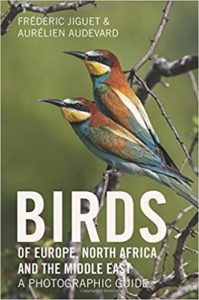 Birds of Europe, North Africa, and the Middle East: A Photographic Guide
Birds of Europe, North Africa, and the Middle East: A Photographic Guide
- By Frédéric Jiguet & Aurélien Audevard; translated by Tony Williams
- Published by Princeton University Press
- Paper list $29.95; ISBN 9780691172439
- 448 pages; 5×7 ½ ; 2,200 color photos and maps
- Publication date: March 22, 2017
This is a new field guide for the birds of Europe. It’s small enough to carry with you in the field (if you don’t mind toting a 1 ¾ lb. book). It has photographs, not drawings, and the authors have pointed out the field marks for each bird commonly found in the area, but the field marks are not emphasized as much as they might be in a drawn guide.
There are photos of the male, female, and juveniles where the plumage differs, and flight photos for many species where that might help identification. There are also some photos of vagrants that do not have the field marks identified. (European warblers tend to look pretty drab—to me—so you can get a warbler “color fix” by looking at American warblers in the vagrant section in the back, although most are shown in winter plumage.)
In the identification section of each species they give the average length or wingspan, and note any characteristic behaviors, as well as differences between races or subspecies where relevant. Where appropriate, they describe the male’s song and often the normal species contact call. Then a description of the normal habitat for the species is given where not obvious (e.g., at sea). Range maps showing the breeding, wintering and resident areas are included.
All the data is located on the same page; you don’t have to refer to a different section for any data. They have followed the “modern” taxonomic order as far as possible, but recognize that the order(s) has been subject to change in light of recent developments. Due to the changes, the scientific names may have changed from earlier guides, even if the common names are the same.
This claims to be the first comprehensive field guide to all the species recorded in Europe, including resident winter visitors, common migrants, and rarities. The guide covers 860 species, with 2,200 photographs. This is probably the best guide to have for the most recent scientific data on each species.

